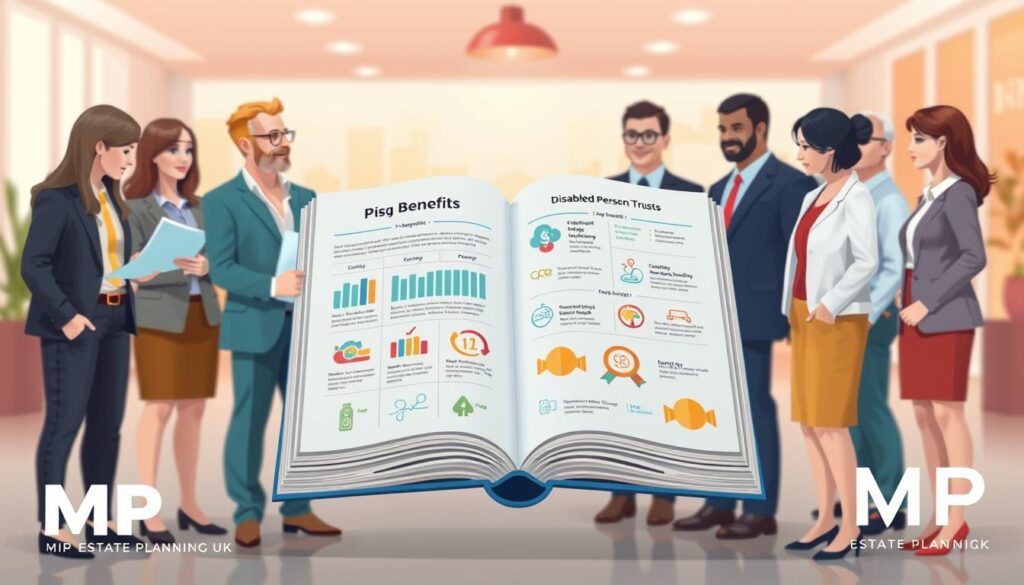Nearly 1.5 million individuals in the UK are living with a disability that significantly impacts their daily lives, highlighting the importance of financial planning for their care. We understand the importance of protecting your loved ones, especially those with disabilities. A Disabled Person’s Trust can be a vital tool in ensuring their financial security.
By establishing a Disabled Person’s Trust, families can safeguard assets for the benefit of their disabled family member while potentially reducing their tax liability. In this article, we will explore the tax benefits and rules surrounding these trusts in the UK, providing a clear understanding of how they work.
Key Takeaways
- A Disabled Person’s Trust can protect assets for a disabled individual.
- These trusts offer potential tax benefits for families.
- Understanding the rules is crucial for effective estate planning.
- Proper planning can ensure the financial security of disabled loved ones.
- Families should consult professionals to navigate the complexities.
What is a Disabled Person’s Trust in the UK?
In the UK, a Disabled Person’s Trust offers a unique solution for families seeking to secure the financial future of their loved ones with disabilities. A Disabled Person’s Trust is designed to provide financial support and protection for individuals who are disabled, ensuring that they are cared for without jeopardizing their eligibility for means-tested benefits.
Definition and Purpose
A Disabled Person’s Trust is typically established to benefit an individual who is disabled, as defined by the relevant UK tax laws. The primary purpose of such a trust is to hold and manage assets for the benefit of the disabled person, ensuring that these assets are used to enhance their quality of life without affecting their entitlement to state benefits.
We will explore how these trusts operate and their tax implications. For more information on accessing trust funds, you can visit https://mpestateplanning.uk/how-to-access-a-trust-fund-in-the-uk/.
Types of Disabled Person’s Trusts
There are several types of Disabled Person’s Trusts available in the UK, each with its own specific characteristics and benefits. The main types include:
- Disabled Person’s Trusts under the Finance Act 2005
- Vulnerable Person Trusts
- Self-Settled Trusts for disabled individuals
Understanding the differences between these trusts is crucial for determining which one is most suitable for your needs.
The table below summarizes the key features of the main types of Disabled Person’s Trusts:
| Type of Trust | Key Features | Tax Implications |
|---|---|---|
| Disabled Person’s Trust under Finance Act 2005 | Established for disabled individuals, assets held for their benefit | Beneficial tax treatment, potentially exempt from inheritance tax |
| Vulnerable Person Trust | Designed for vulnerable individuals, including those with disabilities | Income tax and capital gains tax treated as if income and gains were those of the beneficiary |
| Self-Settled Trust for disabled individuals | Established by the disabled individual or their family | Tax treatment similar to other Disabled Person’s Trusts, with potential for beneficial treatment |
By understanding the different types of Disabled Person’s Trusts and their characteristics, you can make informed decisions about your estate planning and ensure that your loved ones are protected.
Key Benefits of a Disabled Person’s Trust
When considering the financial future of a loved one with a disability, understanding the benefits of a Disabled Person’s Trust is crucial. A Disabled Person’s Trust can provide a secure financial foundation for the beneficiary, ensuring their needs are met without jeopardizing their eligibility for state benefits.
Income Security and Protection
A Disabled Person’s Trust is designed to safeguard the financial well-being of the beneficiary. By placing assets in trust, families can ensure that their loved one receives financial support without directly holding the assets in their name. This arrangement provides income security and protection, as the trust assets are managed by trustees for the benefit of the disabled individual.
One of the primary advantages of a Disabled Person’s Trust is that it allows for the management of assets in a way that supports the beneficiary’s needs while protecting their eligibility for means-tested benefits. According to UK government guidelines, a properly structured trust can ensure that the beneficiary’s eligibility for benefits like Universal Credit remains intact.
Eligibility for Means-Tested Benefits
The assets held in a Disabled Person’s Trust are generally not considered when assessing the beneficiary’s eligibility for means-tested benefits. This is a significant advantage, as it means that the beneficiary can receive financial support from the trust without affecting their entitlement to state benefits.
| Benefit Type | Effect of Disabled Person’s Trust | Benefit Eligibility |
|---|---|---|
| Universal Credit | No impact on eligibility | Remains eligible |
| Housing Benefit | No impact on eligibility | Remains eligible |
| Council Tax Reduction | No impact on eligibility | Remains eligible |
By utilizing a Disabled Person’s Trust, families can ensure that their loved one receives the financial support they need while maintaining their eligibility for essential state benefits. It’s a valuable tool for securing the financial future of individuals with disabilities.

Tax Implications for Disabled Person’s Trusts
Navigating the tax landscape is a critical aspect of managing a Disabled Person’s Trust. Understanding the tax implications can help you make informed decisions and potentially minimize tax liabilities, ensuring that more resources are available for the benefit of the disabled individual.
Income Tax on Trust Earnings
Any income received by the trust is subject to income tax. However, the tax treatment is more favorable for Disabled Person’s Trusts as they are taxed at the vulnerable person’s rate. This means that the trustees are entitled to a deduction in Income Tax, calculated based on what the vulnerable person would have paid if the trust income had been paid directly to them.
For example, if the trust earns £10,000 in a year, the tax liability will be calculated based on the beneficiary’s tax status rather than the trust’s. This can result in significant tax savings, especially if the beneficiary is a non-taxpayer or a basic-rate taxpayer.
Capital Gains Tax Considerations
Capital Gains Tax (CGT) is another important consideration for Disabled Person’s Trusts. When trustees dispose of trust assets, they may be liable for CGT on any gains made. However, there are certain reliefs and exemptions available that can reduce or eliminate this liability.
For instance, if the trust disposes of a property that has been used by the disabled beneficiary as their main residence, it may be eligible for Private Residence Relief. This can significantly reduce the CGT liability, ensuring that more of the trust’s assets are preserved for the beneficiary.
| Tax Relief | Description | Benefit |
|---|---|---|
| Vulnerable Person’s Rate | Income Tax calculated based on the beneficiary’s tax status | Potential tax savings |
| Private Residence Relief | CGT relief for disposal of main residence | Reduced CGT liability |
It’s essential to consult with a tax professional to ensure that you are taking advantage of all available tax reliefs and complying with all tax obligations. By doing so, you can maximize the benefits of the Disabled Person’s Trust and ensure that the beneficiary receives the maximum benefit.
Setting Up a Disabled Person’s Trust
Establishing a Disabled Person’s Trust in the UK involves several crucial steps, including understanding the legal requirements and the roles of those involved. We guide you through the process, ensuring that your trust is set up correctly and operates effectively.
Legal Requirements and Documentation
To establish a Disabled Person’s Trust, you must comply with specific legal requirements. This includes drafting a trust deed that outlines the terms of the trust, the powers of the trustees, and the benefits for the disabled person. The trust deed is a critical document that must be carefully prepared to ensure it meets the legal standards and the needs of the beneficiary.
The choice of trustees is very important. As well as legally owning the assets in trust, they are responsible for managing and administering the trust. Trustees should be chosen based on their ability to act in the best interest of the beneficiary and their competence in managing financial matters.
Key Considerations for Trustees:
- Understanding their legal duties and responsibilities
- Ability to manage trust assets prudently
- Acting in the best interest of the beneficiary
Role of Trustees and Beneficiaries
The trustees play a pivotal role in the administration of the Disabled Person’s Trust. They are responsible for making decisions regarding the investment of trust assets, distributions to the beneficiary, and ensuring compliance with legal and tax obligations. For more detailed guidance, you can refer to our Technical Guide on Disabled Trusts.
Beneficiaries, on the other hand, are the individuals for whose benefit the trust is established. In the case of a Disabled Person’s Trust, the beneficiary is the person with a disability who will receive the benefits from the trust. It’s essential that the trust is set up in a way that preserves their eligibility for means-tested benefits while enhancing their quality of life.

By understanding the roles and responsibilities of both trustees and beneficiaries, you can ensure that the Disabled Person’s Trust is established and operated effectively, providing the maximum benefits while minimizing tax liabilities.
Funding a Disabled Person’s Trust
Funding a Disabled Person’s Trust is a crucial step that requires careful consideration of the available methods and their implications. As we explore the various aspects of funding, it’s essential to understand both the sources of funding and the rules that govern them.
Methods of Funding
There are several ways to fund a Disabled Person’s Trust, each with its own advantages. The primary methods include:
- Lump sum contributions: These can be made from various sources, including inheritances, gifts, or other assets.
- Regular contributions: These can be set up to provide ongoing funding for the trust.
- Transfers from existing trusts or other financial products.
When considering how to fund the trust, it’s crucial to evaluate the tax implications of each method. For instance, lump sum contributions can have significant tax benefits if managed correctly.

Understanding the Contributions and Limits
While funding a Disabled Person’s Trust, it’s vital to understand the limits on contributions, especially when it comes to other beneficiaries. Currently, the trustees are limited as to how much they can receive, being the lower of £3,000 per tax year or 3% of the maximum value of the trust fund.
To illustrate the rules governing contributions and limits, let’s consider the following table:
| Contribution Type | Limit | Tax Implication |
|---|---|---|
| Lump Sum | No specific limit, but subject to IHT | Potential IHT liability if exceeds NRB |
| Regular Contributions | £3,000 or 3% of trust value | Income tax on trust earnings |
| Transfers from Other Trusts | Varies depending on original trust terms | CGT implications on transfer |
Understanding these limits and the associated tax implications is crucial for effective trust management. By carefully planning the funding of a Disabled Person’s Trust, individuals can ensure that they maximize the benefits while minimizing tax liabilities.
Reporting and Compliance Obligations
Ensuring compliance with reporting obligations is crucial for the effective administration of a Disabled Person’s Trust. As trustees or beneficiaries, understanding these obligations helps in maintaining the trust’s integrity and avoiding potential penalties.
Trust Registration Requirements
All trusts, including Disabled Person’s Trusts, are required to register with the Trust Registration Service (TRS). This involves providing detailed information about the trust, its beneficiaries, and the trustees. The registration process is a critical step in ensuring compliance with UK regulations.
Key Information Required for Registration:
- Trust name and details
- Beneficiary information
- Trustee details
- Trust deed or creation document
Annual Tax Returns for Trusts
In addition to registration, trusts are also required to file annual tax returns with HMRC. This involves reporting the trust’s income and capital gains, as well as claiming any applicable tax reliefs.
| Tax Return Component | Description |
|---|---|
| Income Tax | Reporting all income received by the trust, including dividends, interest, and rental income. |
| Capital Gains Tax | Reporting gains or losses from the disposal of trust assets. |
| Tax Reliefs | Claiming reliefs available to the trust, such as the annual exempt amount for capital gains. |
It’s essential to maintain accurate records and seek professional advice to ensure that the trust’s tax returns are filed correctly and on time.

By fulfilling these reporting and compliance obligations, we can ensure that the Disabled Person’s Trust operates smoothly and remains compliant with UK tax laws.
Common Misconceptions About Disabled Person’s Trusts
Clarifying the misconceptions about Disabled Person’s Trusts is essential for families seeking to protect their loved ones. Many believe that these trusts are overly complex or that they offer no real benefits. However, the reality is that Disabled Person’s Trusts can provide significant tax relief and financial security for disabled individuals.
Myths vs. Reality
There are several myths surrounding Disabled Person’s Trusts that need to be addressed:
- Myth: Disabled Person’s Trusts are too complicated to set up. Reality: While they require careful planning, the process is manageable with professional guidance.
- Myth: These trusts are only for the wealthy. Reality: They can benefit families of various financial backgrounds by ensuring the financial security of their disabled loved ones.
- Myth: Disabled Person’s Trusts are not tax-efficient. Reality: They can offer significant tax relief, including UK disability trust tax rules and disability trust tax relief UK.

Clarifying Legal Status
The legal status of Disabled Person’s Trusts can be confusing, but it’s crucial to understand that they are designed to protect the interests of disabled beneficiaries. These trusts are subject to specific regulations and are recognized by HMRC as trusts for vulnerable beneficiaries, entitled to special tax treatment.
Some trusts for disabled people or children get special tax treatment. These are called ‘trusts for vulnerable beneficiaries’. We can help you navigate these regulations to ensure you’re making the most of the available tax relief.
Navigating the Complexities of Trust Law
The complexities of trust law can be daunting, but understanding them is vital for the effective administration of Disabled Person’s Trusts. Trust law governs how these trusts are established, managed, and taxed, making it a crucial area of knowledge for those involved in setting up or managing such trusts.
Relevant Legislation
Several key pieces of legislation govern Disabled Person’s Trusts in the UK. These include:
- The Trusts Act 2000, which outlines the general principles governing trusts, including the duties of trustees and the rights of beneficiaries.
- The Finance Act 2005, which introduced changes to the tax treatment of trusts, including Disabled Person’s Trusts.
- The Mental Capacity Act 2005, which provides a framework for assessing the mental capacity of individuals, including those for whom Disabled Person’s Trusts are established.
Understanding these legislative frameworks is essential for ensuring that a Disabled Person’s Trust is set up and managed correctly. For instance, the Inheritance Tax and Trust Funds guidance can provide valuable insights into the tax implications of such trusts.
Impact on Legal Rights
The legal rights of individuals with Disabled Person’s Trusts are protected through various legal mechanisms. For example:
“The trustees have a fiduciary duty to act in the best interests of the beneficiary, ensuring that the trust is managed in a way that benefits the disabled person.”
This duty is a cornerstone of trust law, providing a safeguard for the beneficiary’s interests. Additionally, the legal framework ensures that the beneficiary’s rights are protected in relation to the trust assets and any income generated by the trust.
A disabled person, as defined by the relevant legislation, is someone who, due to a ‘mental disorder’, is incapable of administering or managing their property or affairs, or qualifies for or receives certain benefits. This definition is crucial in determining eligibility for a Disabled Person’s Trust.

In conclusion, navigating the complexities of trust law is essential for the effective management of Disabled Person’s Trusts. By understanding the relevant legislation and its impact on legal rights, individuals can ensure that these trusts are used to their full potential, providing tax benefits and financial security for disabled persons.
Financial Planning and Management
Financial planning plays a vital role in the administration of a Disabled Person’s Trust, impacting the beneficiary’s quality of life. Effective management ensures that the trust funds are utilized efficiently to support the beneficiary’s needs.
Investment Options for Trust Funds
Trustees have various investment options to grow the trust funds, including:
- Low-Risk Investments: Such as bonds and fixed-income securities, which provide stable returns with minimal risk.
- Diversified Portfolios: Investing in a mix of assets to spread risk and potentially increase returns over the long term.
It’s crucial to balance the need for growth with the requirement to protect the trust assets. For more information on how trust funds can be managed effectively, visit our guide on trust funds and inheritance.
Seeking Professional Financial Advice
Given the complexities involved in managing a Disabled Person’s Trust, seeking professional financial advice is highly recommended. Experts can provide tailored guidance on investment strategies and tax planning, ensuring compliance with UK tax benefits for disabled trusts.
Trustees should also maintain accurate trust accounts and properly manage trust property or investments by taking legal and financial advice. This not only helps in optimizing the trust’s financial performance but also in navigating the disabled person’s trust tax obligations effectively.
Conclusion: Making the Most of a Disabled Person’s Trust
Disabled Person’s Trusts offer a valuable means of protecting the financial future of loved ones with disabilities. By understanding the benefits and complexities of these trusts, families can make informed decisions that safeguard their financial well-being.
Maximizing Tax Benefits
One of the key advantages of a Disabled Person’s Trust is the potential for tax benefits, including disabled trust tax allowances. Families can benefit from effective inheritance tax planning, ensuring that more of their wealth is preserved for the future. By placing assets in a trust, families can also take advantage of disability trust tax relief UK, reducing their tax liability.
Proactive Planning for the Future
To maximize the advantages available, it’s essential to engage in proactive planning. This includes understanding the rules and regulations surrounding Disabled Person’s Trusts, as well as seeking professional advice on setting up and managing the trust. By doing so, families can ensure that their loved ones receive the support they need while minimizing tax burdens.


